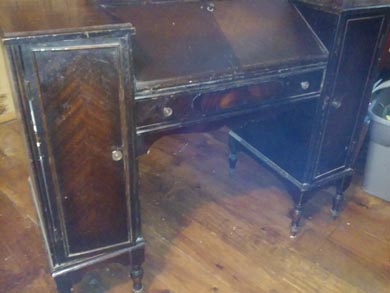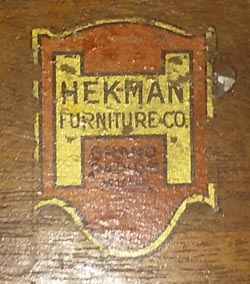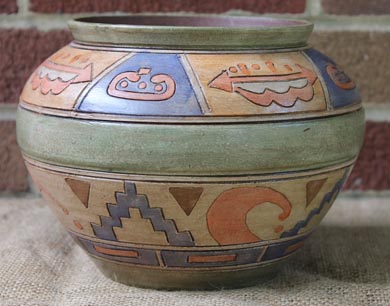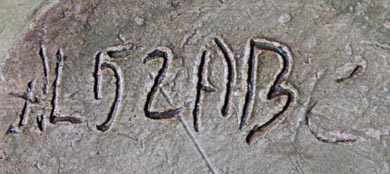 |
|
|||
 |
 |
|||
Copyright © Harry Rinker, LLC 2016 Questions
and Answers
QUESTION: I have a framed oil on canvas painting signed by Anthony Buchta. The painting, entitled “Down in the Ozarks,” features a view between two tall trees of a farmstead fronted by a picket fence with chickens in the foreground. The frame measures 36-inches by 31-inches. The title label on the back has a price of $300.00. My grandfather acquired the painting in 1951, supposedly the result of winning a raffle. What can you tell me about the artist and the value of my painting? – SG, Cadillac, MI, Email Question
ANSWER: Anthony Buchta (June 13, 1896 to December 21, 1967) was born in Cedar Rapids, Iowa. Encouraged by his brother, who also was a commercially trained artist, Anthony attended the Chicago Academy of Fine Arts, continuing his studies at the Chicago Art Institute. He studied landscape painting with Charles Schroeder. His commercial art career included clients such as Montgomery Ward and Sears Roebuck. C. Curry Bohm, Ericson, Turtle, and Buchta traveled to Brown County, Indiana, to paint in the 1920s. He was a member of the Palette and Chisel Club and exhibited at the Brown County Art Guild, Chicago Gallery Association, Chicago Painters and Sculptors, Hoosier Salon, Juliet Arts League, and Scarab Club (Detroit). He won a number of awards. [See: http://fineestateart.com/artists/anthony_buchta; Anthony Buchta has no Wikipedia URL] Anthony Buchta is one of thousands of “local” artists whose collectability and value is limited to a narrowly defined region, in this case, Indiana, Illinois, Iowa, and Missouri. Outside this area, there is limited interest in his work. The good news is there are several Indianapolis private collectors and galleries that are eager to purchase Buchta’s works, especially if Indiana focused. Askart.com and WorthPoint.com list several dozen Anthony Buchta paintings that have been offered for sale over the past three years. An analysis of the sale information indicates that perceived values in Indiana have reached a point where many of the offerings fail to meet reserve, even those pertaining to Brown County. Buchta was extremely prolific, emphasizing sweeping landscapes as opposed to more limited scenes such as the example you own. Since he worked in watercolor and oils, care is required when evaluating prices to make certain that comparable examples match. It also is apparent that Buchta had good, okay, and bad days when his paintings are judged aesthetically. On a scale of one (lowest) to ten (highest) in terms of aesthetic quality, your “Down in the Ozarks” is between a 3 and 4. The value of your painting depends upon where it is offered for sale. If sold in the Indianapolis market, a reasonable estimate is $500.00 to $700.00. If sold by Jackson’s International Auctioneers in Cedar Falls, Iowa, it should sell in excess of $900. I did not consider Leslie Hindman Auctioneers in Chicago because I was concerned the potential sale value may not achieve the Hindman minimum lot requirement. Since the painting features a scene in the Missouri Ozarks, I recommend talking to Selkirk Auctioneers and Appraisers in St. Louis. The final hammer price could exceed $1,500.00. This is a case where the identity of the scene may outweigh the name recognition of the artist in respect to value. The painting is more likely to be featured prominently in a Selkirk sale, although Jackson’s also would market it well. Finally, value is auction-hype contingent. Your painting has a fun acquisition story. QUESTION: I have a French Provincial-style desk made by the Hekman Furniture Company of Grand Rapids, Michigan. The desk features two vertical rectangular ends, each with a triangle-style veneering on the front portion, between which is a slant front desk above a long vertical drawer. The legs feature a turning of a spool above a bulbous vase, ring turns and short tapered feet. How old is my desk and what is it worth? – TL, Poplar Bluff, MO
ANSWER: The Hekman Furniture Company history is fascinating. Edsko Hekman, who emigrated from the Netherlands to Grand Rapids, planned to open a furniture factory. The 1893 Panic altered his plans. Hekman started a bakery that made cookies. It evolved into the Keebler Company. Henry, Jelle, and John, Hekman’s three sons, established the Hekman Furniture Company in 1922. In 1970, Hekman became a division of Beatrice Foods and, in 1983 a division of the Howard Miller Clock Company of Zeeland, Michigan. The Hekman division purchased Woodmark Furniture, established in 1964 and located in High Point, North Carolina, in 1993.
Judging from the images that accompanied your email, the piece requires work. This is a negative in an age when buyers want “room ready” furniture. I suggest obtaining one of the many furniture renewal products, for example, Howard Products’ Restor-A-Finish. Before applying any product, carefully clean the surfaces with mild soapy water. Do one section at a time, drying the rinse water with a towel before moving on to the next section. Although a functional utilitarian piece, especially for an apartment, the Colonial Revival French Provincial-style is unpopular with today’s young adults and the decorating community. Your desk has minimal interest in the countryside and minor interest in a large urban area. Take an accelerating value approach -- $100.00 should sell it quickly; $175.00 if you work hard; and, $250.00 if you are an extremely lucky person. QUESTION: A $20.00 box lot I purchased at auction included a squat bulbous vase measuring 7 3/4-inches in diameter and 6-inches high. The vase has an incised and painted American Indian motif, but it definitely is not Native American. The coarse unfinished clay bottom is inscribed “AL52AB.” The vase weighs two pounds and three ounces. My internet research reveals an identically shaped Newcomb College pottery vase that was sold by Rago Arts in June 2013. This piece is marked “NC/AL52/C/JM. I am certain my vase is not Newcomb College but am puzzled by the similarity in mark information. Can you unravel this mystery? – BM, Kent, Ohio, Email Question
ANSWER: The quality of your vase suggests art pottery. While the fact that it was found in Ohio is not sufficient proof it is a product of an Ohio art pottery, my gut tells me that it is. Another possible origin is a small independent art pottery studio, the identity of which is unknown. I dismissed the possibility that the vase is simply utilitarian or floral ware. The workmanship of the design far exceeds the decorative elements found on these pieces. I did additional research to eliminate a possible Newcomb College origin. First, the coarse clay bottom is not Newcomb. Newcomb pieces had glazed bottoms. Newcomb marks were painted or stamped, never incised. The initials found on your piece are not identified with known Newcomb potters. Finally, I could find not find Newcomb College pottery with this type of Native American motif. Since the vase body is virtually identical in shape between the Newcomb vase and your vase, with the AL52 found on both, one explanation is that AL52 represents a commercial mold number. It is possible that the commercial company sold the same mold to numerous individuals and businesses.
Your vase is an example of “the more that is known, the more valuable the piece is.” At this point, where the vase stands only on its merits, its value is between $85.00 and $100.00. If the company that made it and/or the artist is identified, the value will double or triple. QUESTION: I am seeking a list of pieces in Royal Albert’s Sonatina pattern. Can you provide it? – KK, New Castle, PA, Email Question. ANSWER: I cannot provide it. Replacements, Ltd. (www.replacements.com), may have a complete list in its files. You should email and ask. I consulted several internet websites to create an initial list. You need to continue checking the internet for additional pieces as they come up for sale. With enough persistence, you should be able to assemble a complete list. The website www.royalalbertpatterns.com indicated the pattern was made between 1993 and November 1998. I found the following forms: creamer, cup and saucer - footed; cup – tapered; gravy boat with separate under-plate; plate – bread and butter, plate – dinner, platter -13-inch, oval; sugar bowl, teapot, vegetable bowl – covered; vegetable bowl – 9-inch, oval, open. Although I did not find a reference for it, there must be a salad plate. Good luck in finding additional forms. There must be more.Harry L. Rinker welcomes questions from readers about
collectibles, those mass-produced items from the twentieth and twenty-first centuries.
Selected letters will be answered in this column.
Harry cannot provide personal answers.
Photos and other material submitted cannot be
returned.
Send your questions to: Rinker on Collectibles, 5955 Mill
Point Court SE, Kentwood, MI 49512.
You also can e-mail your questions to
harrylrinker@aol.com.
Only e-mails containing a full name and mailing address
will be considered.
You can listen
and participate in
WHATCHA GOT?, Harry’s
antiques and collectibles radio call-in show, on Sunday mornings between 8:00 AM
and 10:00 AM Eastern Time.
If you
cannot find it on a station in your area,
WHATCHA GOT?
streams live on the Internet at www.gcnlive.com.
SELL, KEEP OR TOSS?: HOW TO DOWNSIZE A HOME,
SETTLE AN ESTATE, AND APPRAISE PERSONAL PROPERTY
(House of Collectibles, an imprint of Random House Information Group, $17.99),
Harry’s latest book, is available at your favorite bookstore and via
www.harryrinker.com.
|
||||



 Your Hekman French Provincial-style desk was made during the height of the mid-1920s-1930s Colonial Revival design style movement. It combines a wide variety of design-style elements from other furniture styles, a typical approach for 1920s-1930s Colonial Revival furniture.
Your Hekman French Provincial-style desk was made during the height of the mid-1920s-1930s Colonial Revival design style movement. It combines a wide variety of design-style elements from other furniture styles, a typical approach for 1920s-1930s Colonial Revival furniture.
